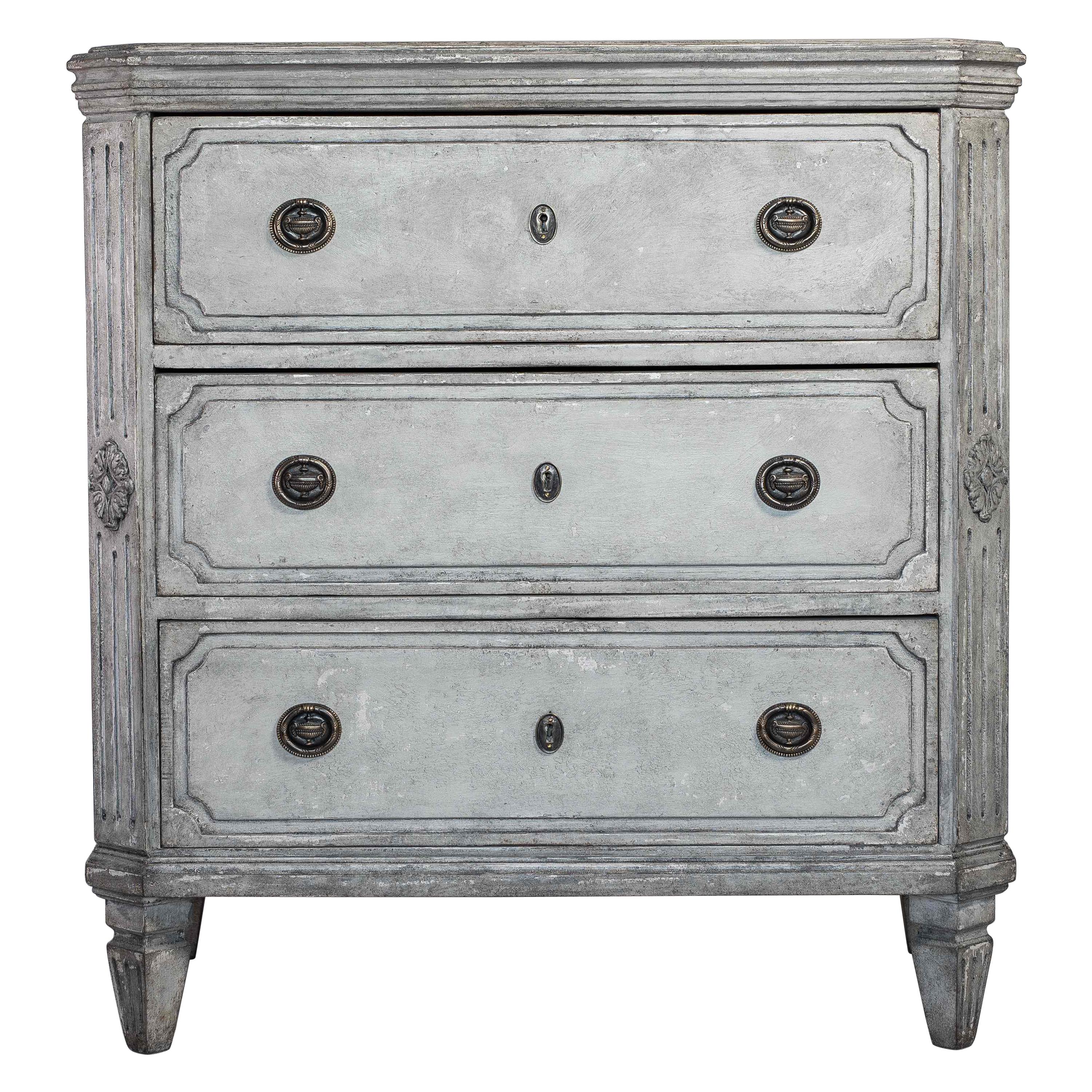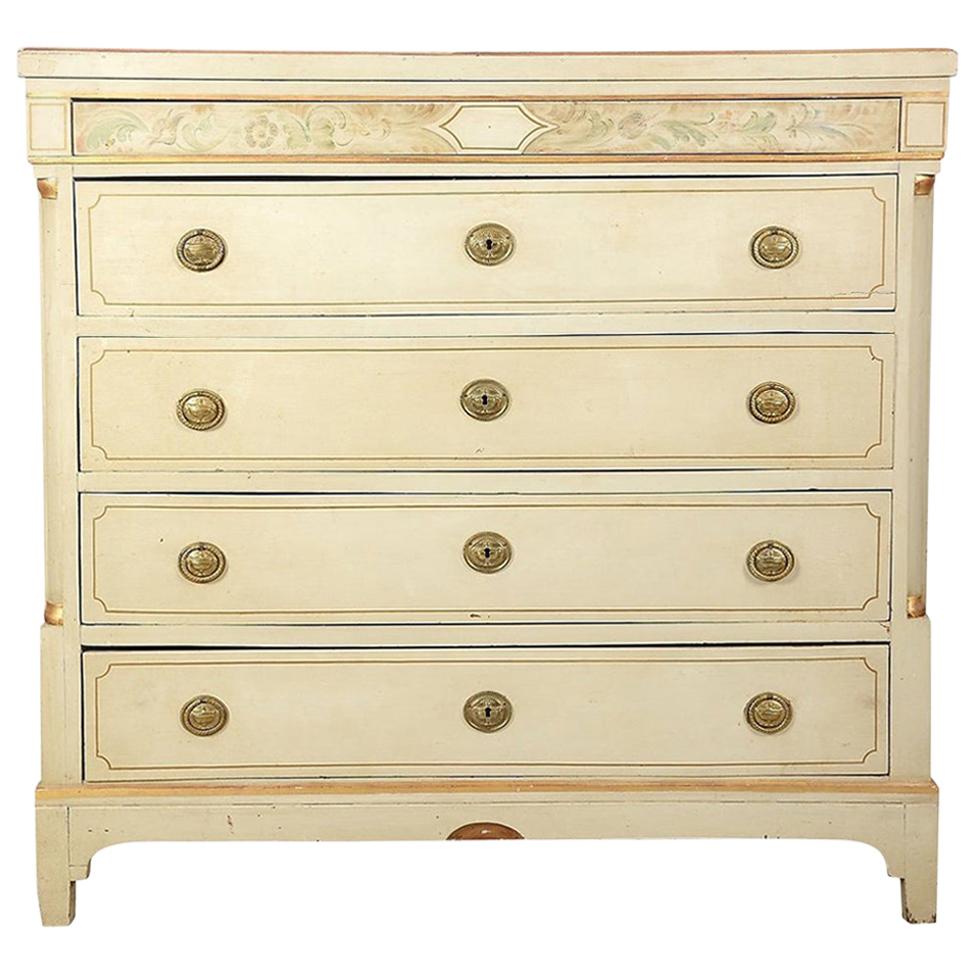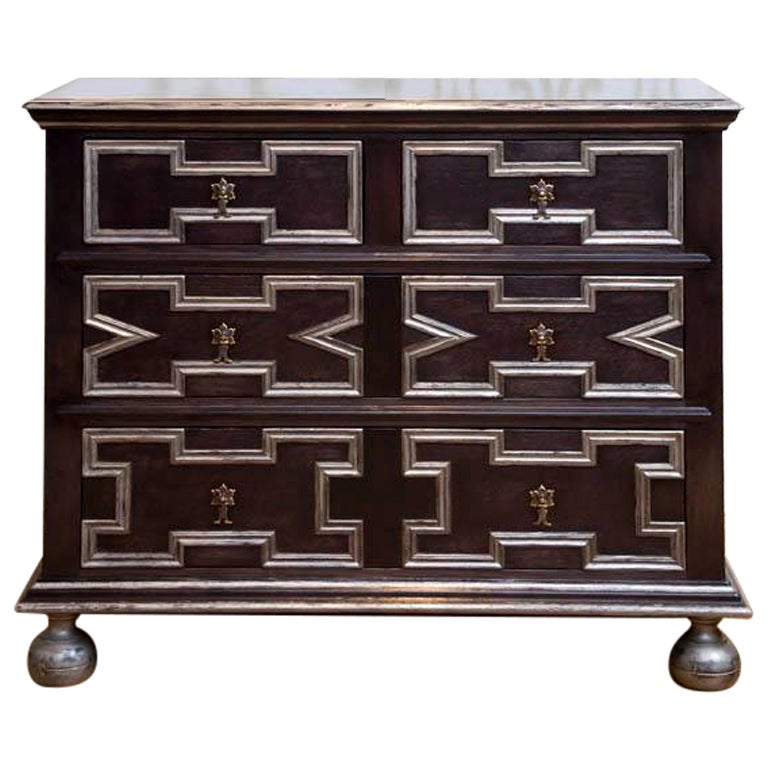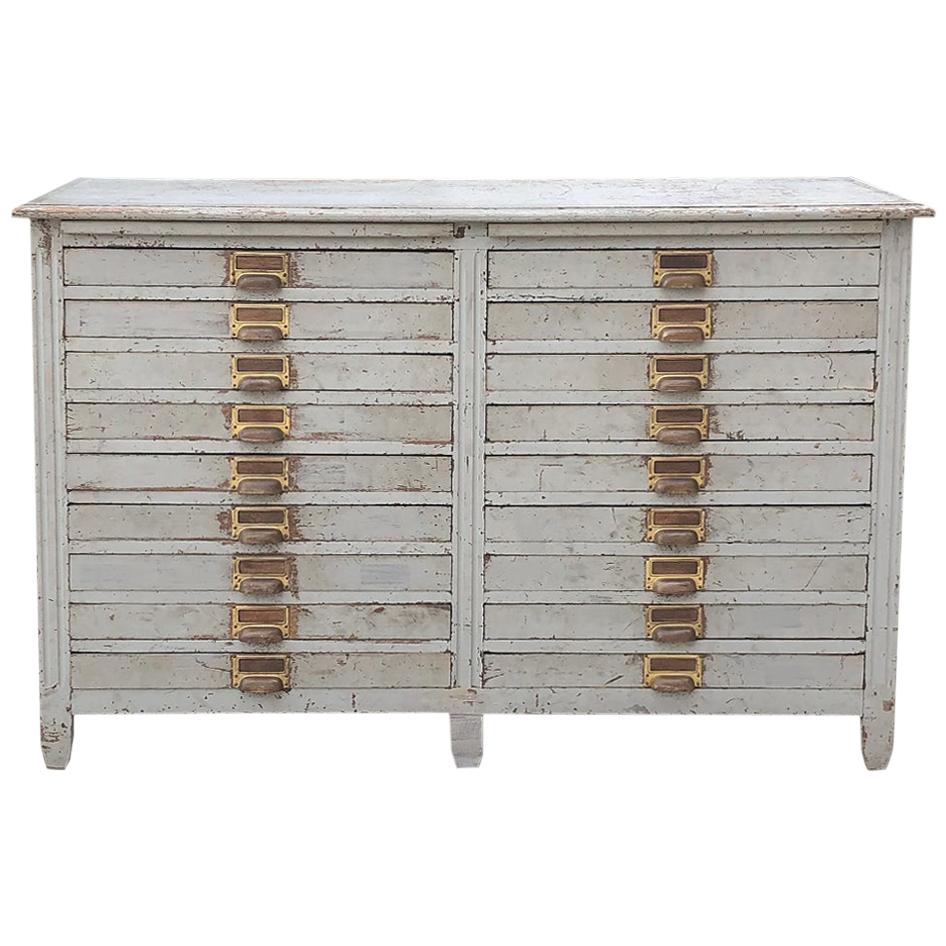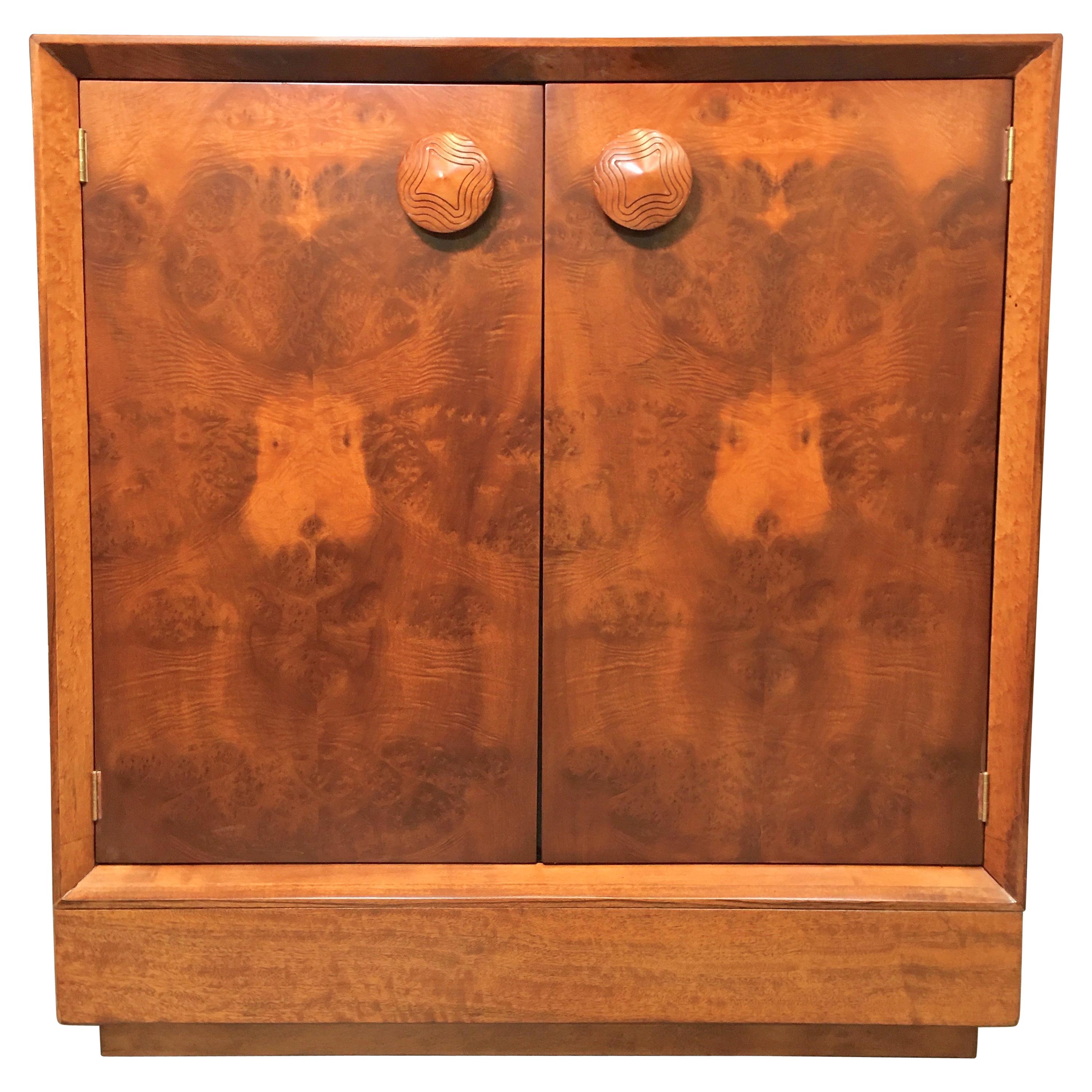Items Similar to Angus Ross Cabinet Tallboy Drawers
Want more images or videos?
Request additional images or videos from the seller
1 of 11
Angus Ross Cabinet Tallboy Drawers
About the Item
This cabinet was designed and produced by Scottish based craftsman Angus Ross in 2000. He was commissioned by The Wilson Art Gallery and Museum to build a museum quality cabinet to display their costume and textile collection. The cabinet has since been fitted to function as a tall boy chest of drawers. The doors are intricately veneered with burr maple marquetry arranged in a sunburst pattern around the oval porthole. Visible through the porthole are two solid oak drawers with vertically recessed drawer pulls creating a surreal stepped perspective. There is a wave shape cut from the bottom of the doors which also reveals the oak drawer behind, contributing to the absurdist nature of the design. Behind the doors are 9 drawers of varying heights.
Angus Ross is a designer, craftsman and woodsman. He combines ancient, traditional and modern woodwork techniques and is particularly known for steam-bending. His studio-workshop is in Highland Perthshire and he sources timber from a local bluebell wood which is co-owned and managed by Angus to improve: bio-diversity; the long-term quality of the timber; and amenity use of the woodland by others.
His furniture is found in the Scottish Design Gallery of V&A Dundee, Inverness Museum and Art Gallery, Cheltenham Museum and widely published including Craft Britain:Why Making Matters, Helen Chislett and David Linley 2022. He is in the Homo Faber Guide : an international collection of the best craft and design by the Michaelangelo Foundation for Creativity and Craftsmanship, widely exhibited at international craft fairs including: COLLECT, London; Philadelphia Museum of Art; Decorex, London Craft Weeks, London Design Festival and is a selected maker for the Crafts Council and CraftScotland.
Dimensions: H190cm W70cm D73cm
Free shipping within the London area.
- Dimensions:Height: 74.81 in (190 cm)Width: 27.56 in (70 cm)Depth: 28.75 in (73 cm)
- Style:Post-Modern (Of the Period)
- Materials and Techniques:
- Place of Origin:
- Period:1990-1999
- Date of Manufacture:1999
- Condition:Additions or alterations made to the original: Two drawers have been added to the top. Wear consistent with age and use. Minor losses. Minor structural damages.
- Seller Location:London, GB
- Reference Number:1stDibs: LU7053231717192
About the Seller
5.0
Vetted Seller
These experienced sellers undergo a comprehensive evaluation by our team of in-house experts.
Established in 2012
1stDibs seller since 2022
Typical response time: 1 to 2 days
- ShippingRetrieving quote...Ships From: London, United Kingdom
- Return PolicyA return for this item may be initiated within 14 days of delivery.
More From This SellerView All
- Compass Writing Desk Bureau by Pedro Miralles Claver for Punt Mobles, circa 1990Located in London, GBThe compass desk was designed by Pedro Miralles Claver for Punt Mobles, circa 1990. One of Pedro Miralles last designs before his untimely death in 1993...Category
1990s Spanish Post-Modern Desks and Writing Tables
MaterialsWood, Cherry
- Vintage King Costes chair by Philippe Starck for Aleph, circa 1992By Driade, Philippe StarckLocated in London, GBA vintage King Costes chair by Philippe Starck for Aleph, circa 1992. Curved plywood back with aluminium legs and beige leather seat. The condition is e...Category
1990s Italian Post-Modern Chairs
MaterialsAluminum
- 1980's Italian Memphis Dining Table by Sottsass Associati for BieffeplastBy Sottsass Associati, BieffeplastLocated in London, GBDesigned by Sottsass Associati and produced by Bieffeplast circa 1980’s. The ‘Crossing’ table features a robust black powder coated tubular steel frame, chrome trimmings and toughene...Category
Vintage 1980s Italian Post-Modern Dining Room Tables
MaterialsSteel, Chrome
- Stefan Knapp Enamel Painting on Steel Panel 'Untitled' 1989By Stefan KnappLocated in London, GBBorn in Poland in 1921, Knapp was arrested by the Russians in 1939 at the age of eighteen, and sent to a prison camp in Siberia. He was released in 1941 and then undertook an epic journey through numerous countries still at war, eventually making it to Britain, where he enrolled in the RAF and spent several years as a Spitfire pilot. The dramatic aerial perspective of the world that he experienced during this time would become highly influential in his painting. In 1947 he enrolled in London’s Central School of Arts, following which he studied at the Slade School of Art. In 1953 Knapp discovered the remarkable luminescent qualities of jewellery enamel while attempting to fix a girlfriend’s broach that she had broken after secretly borrowing it from her father’s collection. He immediately began experimenting on sheets of copper, and before long was producing enormous panels of up to ten feet long. There was a tremendous building boom at this time both in Europe and America and Knapp envisaged buildings throughout cities being clad with vibrant enamel exteriors. In 1957 he adapted his technique to suit steel which was stronger than copper and the earliest accomplished examples of this important development were shown in an exhibition at Pierre Matisse Gallery in New York the same year. In 1958 he received his first chance to realise his dream when he was commissioned to create seventeen large murals for Heathrow Airport. Many other major commissions followed, including an enamel mural for the Seagram Building in New York, and the Alexander Corporation, New Jersey, in 1960 which was the largest mural ever created, measuring 200 x 50 feet. Knapp created these large-scale works with the vision that they would transform the meaning of the architecture and buildings they adorned. By the 1960’s Knapp had achieved international acclaim and exhibited extensively throughout the world. The artist’s work is represented in numerous major museums of modern art, including: Museum of Fine Art, Dallas; Museum of Modern Art, New York; The Tate Gallery, London; Museum of Fine Arts, Boston; Hall of Fame Museum, Mexico City; Breda Museum; Katowice Museum, Poland; Royal Palace, Rabat; The Art Center, Milwaukee; San Jose Museum of Arts, U.S.A.; Holocaust Museum...Category
Vintage 1980s British Post-Modern Decorative Art
MaterialsEnamel, Steel
- Alvar Aalto Model 83 Table and Model 66 ChairsBy Alvar AaltoLocated in London, GBA vintage model 83 dining table by Alvar Aalto for Artek made of Finnish Birch ply & 8 model 66 chairs in the same wood. This set is over 20 years old but the exact production date is unclear. There are no stamps or marks related to Artek but the build quality and features are enough to verify its authenticity. The condition of the set is good, the table and chairs are all very solid with minimal dents or chips. There are a couple of chairs showing signs of more use than others, however all seat conditions are visible in the photos provided. There is one small mark on the table top which has been pictured with regular house keys...Category
Vintage 1970s British Mid-Century Modern Dining Room Sets
MaterialsBirch, Plywood
- Vintage Black No. 222 Chairs by by Robert Mallet StevensBy Robert Mallet-StevensLocated in London, GBA set of 4 newly restored No.222 stacking chairs by Robert Mallet Stevens. Lacquered black metal in excellent condition with new rubber pads under the legs. Dimensions: W40cm D46c...Category
Vintage 1950s French Mid-Century Modern Chairs
MaterialsSteel
You May Also Like
- Swedish Gustavian Painted Chest of Drawers Commode Tallboy 1860 Grey WhiteLocated in LONDON, GBC 1860 antique Swedish Gustavian painted chest of drawers commode with detailed decorative motifs on the top rail, f...Category
Antique Late 19th Century Swedish Gustavian Commodes and Chests of Drawers
MaterialsPine
- Swedish Gustavian Painted Chest of 9 Drawers Commode Tallboy 1870 Grey WhiteLocated in LONDON, GBPlease note - this item will be available to ship form march 2022 C 1870 antique Swedish Gustavian painted chest of 9 drawers commode with detailed...Category
Antique Late 19th Century Swedish Gustavian Commodes and Chests of Drawers
MaterialsPine
- Swedish Gustavian Painted Chest of Drawers Commode Tallboy, 19th Century WhiteLocated in LONDON, GB19th century antique Swedish Gustavian painted chest of drawers commode with detailed hand painted designs on the top rail and gilt detailing. It has four drawers with brass ring ...Category
Antique Late 19th Century Swedish Gustavian Commodes and Chests of Drawers
MaterialsBirch
- Jacobean Oak Ebonized/Silver Chest of DrawersLocated in Cranbrook, KentJacobean Revival Ebonized Oak and Silver relief Chest of Drawers made in solid English Oak using the best high end cabinet makers. A fresh to market fi...Category
2010s English Jacobean Commodes and Chests of Drawers
MaterialsOak
- 19th Century Architectural Plan, Collector's CabinetLocated in Dallas, TX19th century architectural plan, collector's cabinet features multiple shallow drawers perfect for keeping a large inventory of blueprints and sketc...Category
Antique 1890s French Industrial Commodes and Chests of Drawers
MaterialsOak
- Gilbert Rohde Paldao Cabinet for Herman MillerBy Gilbert Rohde, Herman MillerLocated in Hanover, MAGilbert Rohde designed this chest for Herman Miller as part of his 1941 Paldao Line of streamline modernist and modular furniture in exotic veneer. This is model no. 4103, two-door cabinet with distinctively incised large round pulls, interior fitted with two adjustable shelves behind the left door and five pull-out drawers behind the right door, fronts finished in black enamel. The case top and sides are Paldao wood; the doors are in highly figured burl Acacia. The finish is called "Beaver" which is natural color, no stain, satin varnish. The back is numbered "4130." All of Rohde's designs for Herman Miller are marked with a 4-digit number; the first two numbers indicate the year, and the second two numbers indicate the individual piece. Newly refinished and ready to place in your home. The Herman Miller Furniture Company was devoted to manufacturing period reproduction furniture until Pioneer industrial designer Gilbert Rohde walked into their Grand Rapids showroom in 1930. A devout modernist, Rohde convinced D.J. De Pree to focus on modern furniture throughout the 1930s, and to produce exclusively modern furniture by the time Rohde died in 1944. Work by the pioneering American industrial and furniture designer, Gilbert Rohde, is notable for its thoroughly modern, informal, and multifunctional qualities. Rohde’s ability to create appealing modernist furnishings for middle-class homes, while also devising merchandising strategies to sell these goods, places him within a unique framework in American design history. Born and raised in New York, Rohde was the son of a cabinetmaker. He attended New York City public schools and his post-high school education included courses at the Art Students League and the Grand Central School of Art. Rohde’s visit to Europe in the spring and summer of 1927 (with later trips in 1931 and 1937) to see the Bauhaus in Dessau and the French modernist design that debuted in the 1925 Exposition Internationale des Arts Décoratifs et Industriels Modernes in Paris, profoundly inspired his concept of design and the role it should play in daily life. The French Art Deco and German rationalist styles he saw in Europe influenced the furniture he designed from the late 1920s into the 1940s, pieces he created to suit a rapidly changing American lifestyle. In addition to his work for Herman Miller Inc., Rohde also designed for several other furniture firms, including Thonet, Troy Sunshade, and Heywood-Wakefield. What set Rohde apart from his contemporaries was his all-encompassing understanding of the furniture industry, from design and production to marketing and showroom display.[1] During his time with Herman Miller Inc. (1932-1944), Rohde set the standard for collaborative efforts between designers and furniture firms, with George Nelson and Charles and Ray Eames later...Category
Vintage 1940s American Mid-Century Modern Commodes and Chests of Drawers
MaterialsMahogany
Recently Viewed
View AllMore Ways To Browse
Shape Of Hand
London Vintage Design
Crafts Of The Kingdom
Designer Craftsman
Tall Vintage Drawers
Burr Drawers
Timber Cabinet
Tall Wood Drawers
Vintage Chest Of Drawers With Doors
Tall Cabinets With Drawers And Doors
Chest With Gallery
Timber Drawers
Step Drawers
Craftsman Cabinet
Museum Drawers
Cabinet Modern Vertical
Solid Wood Vintage Chest Of Drawers
Solid Wood Chest Of Drawers Vintage

